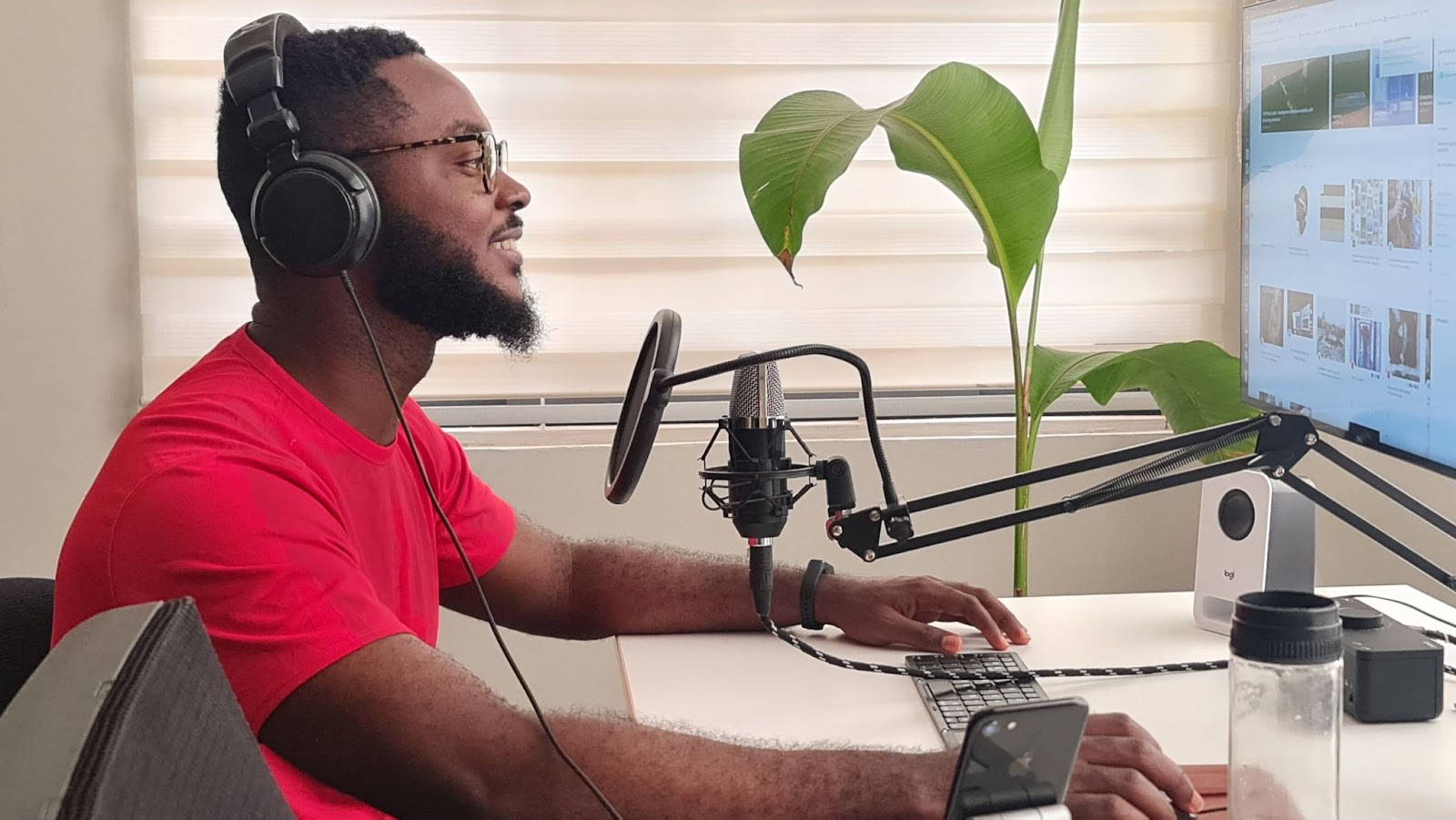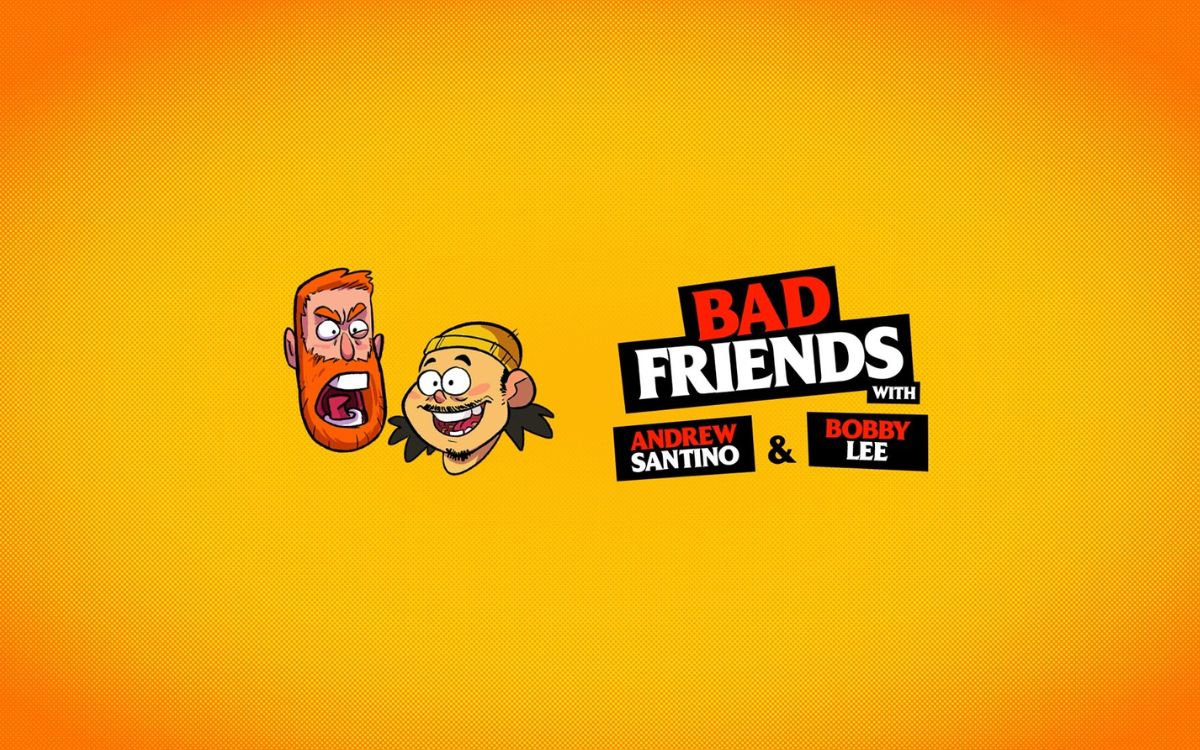Home>Events & Info>Podcast>How To Make A Podcast Trailer


Podcast
How To Make A Podcast Trailer
Modified: January 22, 2024
Learn how to create an engaging podcast trailer and attract a wider audience with our step-by-step guide. Enhance your podcasting skills and promote your show effectively.
(Many of the links in this article redirect to a specific reviewed product. Your purchase of these products through affiliate links helps to generate commission for AudioLover.com, at no extra cost. Learn more)
Table of Contents
- Introduction
- Step 1: Determine the Purpose of Your Podcast Trailer
- Step 2: Outline the Content
- Step 3: Write a Compelling Script
- Step 4: Gather or Record Audio Clips
- Step 5: Add Background Music or Sound Effects
- Step 6: Edit and Mix the Audio
- Step 7: Create a Captivating Intro and Outro
- Step 8: Choose an Engaging Visual Element
- Step 9: Export and Save the Trailer
- Step 10: Share and Promote Your Podcast Trailer
- Conclusion
Introduction
Podcasts have become increasingly popular in recent years, offering a convenient and engaging way for people to consume audio content on a wide range of topics. If you’re planning to start a podcast, creating a podcast trailer is a crucial step to attract and captivate your potential audience. A well-crafted trailer can pique the curiosity of listeners, giving them a taste of what they can expect from your podcast.
In this article, we will guide you through the process of creating a compelling podcast trailer that grabs attention and leaves a lasting impression. From determining the purpose of your trailer to sharing and promoting it, we will cover all the essential steps to help you make a podcast trailer that stands out.
Before we delve into the details, it’s important to note that the techniques outlined here can be applied to any type of podcast, whether it’s an informational show, an interview-based series, or a storytelling podcast. The goal is to create a trailer that reflects the essence of your podcast and entices listeners to subscribe and tune in to your episodes.
So, let’s get started and discover how to make a podcast trailer that generates excitement and intrigue!
Step 1: Determine the Purpose of Your Podcast Trailer
Before diving into the creative process of making your podcast trailer, it’s essential to clarify the purpose and objectives you want to achieve. Understanding the purpose will help you craft a trailer that aligns with your podcast’s overall goals and resonates with your target audience.
The purpose of your podcast trailer may vary depending on various factors, such as the stage of your podcast’s launch, the genre or niche you’re targeting, and the specific message you want to convey. Here are a few common purposes for creating a podcast trailer:
- Introduce Your Podcast: If your podcast is new, the main goal of your trailer is to introduce your show to potential listeners. You want to give a brief overview of the topics you’ll cover, the format of your podcast, and what makes it unique.
- Tease Unreleased Episodes: If you’re an established podcaster with a loyal following, you can use your trailer to tease upcoming episodes or seasons. This creates anticipation among your audience and keeps them engaged.
- Showcase Highlights: A trailer can be an opportunity to showcase the best moments from your existing episodes. This can give listeners a taste of the content they can expect from your show and entice them to explore more.
- Build Excitement: Your trailer can serve as a teaser that builds excitement and curiosity around your podcast. By incorporating intriguing soundbites or compelling narratives, you can leave listeners wanting more.
When determining the purpose of your podcast trailer, consider your target audience and what will resonate with them. Think about the specific message or feeling you want to convey and how it aligns with the overall branding and tone of your podcast. This clarity will guide you as you move forward with the rest of the trailer creation process.
Now that you have a clear purpose in mind, let’s move on to the next step: outlining the content for your podcast trailer.
Step 2: Outline the Content
Once you have determined the purpose of your podcast trailer, it’s time to outline the content that will be included. The content outline will serve as a roadmap for creating your script and ensure that you cover all the key elements necessary to make an engaging trailer.
Here are some important points to consider when outlining the content for your podcast trailer:
- Introduce Your Podcast: Start by introducing your podcast and providing a brief overview of what it’s about. Clearly communicate the main theme or topics you’ll cover, and highlight any unique aspects that set your podcast apart.
- Explain the Format: Give your audience an idea of the format of your podcast. Will it be a solo show, an interview-style format, or a narrative storytelling approach? Briefly explain how you will present your content to help listeners understand what to expect.
- Showcase Compelling Content: Select a few snippets from your best episodes that showcase the most compelling content. These can be interesting stories, thought-provoking discussions, or surprising insights. Choose moments that will pique the curiosity and interest of your potential listeners.
- Highlight Guest Speakers: If your podcast features guest speakers or experts, mention their names and briefly explain why they are worth listening to. This can add credibility and intrigue to your trailer.
- Invoke Emotion: Consider how you want your listeners to feel when they hear your trailer. Do you want to evoke excitement, curiosity, or a sense of inspiration? Incorporate elements in your content outline that will elicit the desired emotional response.
- Call to Action: End your trailer with a strong call to action. Encourage listeners to subscribe to your podcast, leave reviews, or visit your website for more information. Make it clear how they can take the next step in engaging with your show.
Remember, your content outline is a flexible guide that can be adjusted and refined as you work on your script. It’s important to strike a balance between providing enough information to entice listeners and keeping the trailer concise and engaging.
With your content outline in place, you can now move on to the next step: writing a compelling script for your podcast trailer.
Step 3: Write a Compelling Script
Writing a compelling script is a crucial step in creating an engaging podcast trailer. Your script will guide the narration and dialogue, ensuring that your trailer effectively communicates the key elements and hooks your audience from the very beginning.
Here are some tips for writing a compelling script for your podcast trailer:
- Start with a Hook: Capture your listeners’ attention right from the start with a compelling opening line or a thought-provoking question. This will make them curious and eager to listen further.
- Be Clear and Concise: Keep your script concise and avoid rambling. Use clear and simple language, and get straight to the point. Remember, you only have a limited time to make an impact.
- Inject Personality: Let your personality shine through in your script. Use your natural tone and speaking style to make a genuine connection with your audience. Inject humor, enthusiasm, or excitement where appropriate.
- Create Visual Imagery: Paint a vivid picture in your listeners’ minds by using descriptive language. This helps them visualize the content and makes it more engaging and memorable.
- Include Soundbites: Incorporate short soundbites from your podcast episodes to add variety and showcase the intriguing content you offer. These snippets can highlight interesting discussions, poignant moments, or powerful quotes.
- Build Momentum: Create a sense of anticipation and build momentum throughout your trailer. Gradually reveal more exciting aspects of your podcast as the script progresses, leaving your audience wanting to hear more.
- End with Impact: Finish your script with a powerful closing statement that reiterates the main message of your trailer and leaves a lasting impression. Include a clear call to action, encouraging listeners to subscribe and engage with your podcast.
As you write your script, put yourself in the shoes of your target audience. Consider what would capture their attention and resonate with them. Write and revise your script until you feel it effectively represents the purpose and content of your podcast trailer.
Once your script is finalized, it’s time to move on to the next step: gathering or recording audio clips for your podcast trailer.
Step 4: Gather or Record Audio Clips
Now that you have a compelling script for your podcast trailer, it’s time to gather or record the audio clips that will bring your script to life. Audio clips add depth and authenticity to your trailer, allowing listeners to get a taste of the actual content and voices they can expect from your podcast.
Here are some ways to gather or record audio clips for your podcast trailer:
- Extract Clips from Existing Episodes: If you have already launched episodes for your podcast, review them to find moments that align with your script and represent the best of your content. Extract these snippets to include them in your trailer.
- Record New Clips: In some cases, you may want to record new audio clips specifically for your trailer. This can involve having conversations with guest speakers, conducting interviews, or creating fresh content that complements your script.
- Use Voiceovers: Consider using professional voiceover artists or even your own voice to narrate specific parts of your script. This can add a polished and professional touch to your trailer.
- Utilize Sound Effects: Enhance the impact of your trailer by incorporating sound effects that complement your content and help create a more immersive experience for your listeners. This can include ambient sounds or relevant sound cues.
Remember to ensure that the audio clips you use align with the tone and quality you want to convey for your podcast. Pay attention to sound quality, clarity, and coherence to maintain a professional and engaging trailer.
Once you have gathered or recorded the necessary audio clips, you can proceed to the next step: adding background music or sound effects to enhance your podcast trailer.
Step 5: Add Background Music or Sound Effects
Adding background music or sound effects to your podcast trailer is an effective way to enhance the overall ambiance and create a more engaging listening experience for your audience. The right choice of music and sound effects can complement your content, set the mood, and evoke the desired emotions in your listeners.
Here are some considerations when adding background music or sound effects to your podcast trailer:
- Choose the Right Music: Select background music that aligns with the theme and tone of your podcast. Consider the genre, tempo, and instrumentation to create the desired atmosphere. You can opt for royalty-free music libraries or commission original compositions.
- Match Music to the Content: Time the music to match the pace and content of your trailer. Use softer, more contemplative music for introspective moments, and upbeat or intense music for exciting or energetic parts of your trailer.
- Avoid Distracting Sound Effects: While sound effects can enhance certain moments in your trailer, make sure they don’t overpower the narration or distract listeners. Use them sparingly and strategically, focusing on those that enhance the storytelling or add depth to the audio.
- Maintain Balance: Ensure that the background music and sound effects don’t overpower the dialogue or the overall audio quality of your trailer. Adjust the volume levels to maintain a balance that allows the key elements of your trailer to be clearly heard.
- Consider Copyright and Licensing: If you choose to use copyrighted music or sound effects, be mindful of licensing restrictions. Make sure you have the necessary permissions or opt for royalty-free or creative commons licensed options that allow for use in your podcast trailer.
Adding background music and sound effects can elevate the production value of your podcast trailer and make it more dynamic and engaging for your audience. Experiment with different options and trust your instincts to create the perfect blend of audio elements that enhances your trailer’s impact.
With background music and sound effects added, it’s time to move on to the next step: editing and mixing the audio for your podcast trailer.
Step 6: Edit and Mix the Audio
Once you have all the necessary audio elements for your podcast trailer, it’s time to edit and mix them to create a polished and cohesive final product. Editing and mixing the audio ensures that the narration, dialogue, music, and sound effects blend seamlessly together, creating a professional and engaging listening experience.
Here are some key steps to consider when editing and mixing the audio for your podcast trailer:
- Trim and Arrange Clips: Start by trimming any unwanted or unnecessary parts of your audio clips. Arrange them in a logical order that follows the flow of your script.
- Adjust Audio Levels: Ensure that all the audio elements, including the narration, dialogue, music, and sound effects, have consistent volume levels. This helps prevent any parts from being too loud or too soft.
- Smooth Transitions: Use fades or crossfades to create smooth transitions between clips. This helps avoid abrupt cuts or jarring changes in audio that can be distracting to listeners.
- Enhance Clarity: Apply equalization (EQ) and compression to improve the clarity and intelligibility of the narration and dialogue. This helps balance the frequency range and regulate the dynamics of the audio.
- Remove Background Noise: Use noise reduction tools to eliminate any background noise or unwanted hiss that may be present in the audio. This ensures a cleaner and more professional sound.
- Pan and Spatialize: Consider panning certain audio elements to create a sense of space and dimension. This can add depth and immersion to your trailer’s audio.
- Ensure Smooth Music Integration: Check that the background music blends seamlessly with the narration and dialogue. Make any necessary adjustments in volume or timing to ensure a cohesive sound.
- Review and Polish: Listen to your trailer multiple times to ensure there are no audio glitches, pops, or other technical issues. Make any final adjustments to achieve the desired audio quality.
Editing and mixing the audio is a crucial step in creating a professional and high-quality podcast trailer. Take your time to fine-tune and polish the audio, paying attention to detail to ensure a seamless and enjoyable listening experience for your audience.
With the audio edited and mixed, you’re ready for the next step: creating a captivating intro and outro for your podcast trailer.
Step 7: Create a Captivating Intro and Outro
The intro and outro of your podcast trailer are critical components that help bookend the overall listening experience. These sections serve as the first and last impression for your audience, so it’s essential to create captivating and memorable intros and outros that leave a lasting impact.
Here are some tips for creating captivating intros and outros for your podcast trailer:
- Capture Attention: Your intro should grab the listener’s attention right from the start. Use a catchy hook, an intriguing question, or a compelling statement to captivate your audience and make them curious to keep listening.
- Set the Tone: The intro should give a glimpse of the tone and style of your podcast. Reflect the overall mood, whether it’s lighthearted, informative, thought-provoking, or something else, to give listeners an idea of what to expect.
- Introduce Host or Narrator: Use the intro to introduce yourself as the host or narrator of the podcast. Share your name, credentials, and a brief summary of your expertise to establish credibility.
- Highlight Unique Selling Points: Showcase the unique aspects of your podcast that set it apart from others in your niche. This can include the specific topics you cover, the approach you take, or the value you provide to your audience.
- End with a Call to Action: In your outro, encourage listeners to take action. This could be subscribing to your podcast, leaving reviews, sharing with friends, or visiting your website for more information. Make it clear and easy for them to follow through.
- Add Music or Sound Effects: Consider incorporating background music or sound effects in the intro and outro to enhance the overall impact and create a cohesive listening experience.
- Maintain Consistency: Ensure that the style, tone, and branding elements of your intro and outro align with the rest of your podcast. Consistency helps to build recognition and familiarity among your listeners.
- Make it Memorable: Aim to make your intro and outro memorable, so it sticks in the minds of your audience. Use catchy phrases, unique identifiers, or memorable jingles to make a lasting impression.
Take the time to brainstorm and experiment with different ideas for your intro and outro. Consider what resonates with your audience and aligns with the overall tone and branding of your podcast. Once you have crafted a captivating intro and outro, you are one step closer to completing your podcast trailer.
Now, it’s time to choose an engaging visual element for your trailer. Let’s move on to step 8!
Step 8: Choose an Engaging Visual Element
While podcasts primarily rely on audio content, incorporating a visually engaging element in your podcast trailer can make it more attention-grabbing and memorable. Adding a visual component can also aid in branding and recognition, helping your trailer stand out among the competition.
Here are some considerations when choosing an engaging visual element for your podcast trailer:
- Create a Logo: Design a unique and eye-catching logo that represents your podcast. This logo can be displayed throughout your trailer to create visual recognition for your brand.
- Use Imagery or Graphics: Incorporate relevant imagery or graphics that align with the theme and content of your podcast. This could be illustrations, photographs, or even animations that add visual interest and reinforce your message.
- Utilize Text or Typography: Experiment with different fonts and typography styles to display key words, phrases, or quotes from your podcast trailer. This can help emphasize important points and convey a sense of your podcast’s style.
- Consider Motion or Animation: If possible, explore adding motion or animation to your visual element. This can bring your logo, imagery, or text to life, making it more captivating and engaging for viewers.
- Maintain Consistency: Ensure that the visual element aligns with your podcast’s overall branding, including colors, style, and tone. Consistency helps establish a professional and cohesive visual identity.
- Optimize for Different Platforms: Keep in mind that your podcast trailer may be shared on various platforms, such as social media or video hosting sites. Consider optimizing your visual element for different sizes and formats to ensure it looks great across all platforms.
- Create a Thumbnail: Along with the visual element for your podcast trailer itself, design an attention-grabbing thumbnail that entices potential listeners to click and watch. This thumbnail should effectively represent your trailer and be consistent with your podcast’s branding.
Choosing an engaging visual element for your podcast trailer adds an extra layer of appeal and professionalism. It helps draw in viewers and creates a visual representation of your podcast, making it more memorable and shareable.
Once you have selected your visual element, it’s time to export and save your podcast trailer. Let’s move on to step 9!
Step 9: Export and Save the Trailer
After putting in the efforts to create a compelling podcast trailer, the next step is to export and save your final product. This ensures that your trailer is in a format that can be easily shared, uploaded, and promoted across various platforms.
Here are some important considerations when exporting and saving your podcast trailer:
- Choose the Right File Format: Select a file format that is widely supported and compatible with your intended distribution platforms. MP3 is a common choice for audio files, while MP4 or MOV formats are often used for videos.
- Determine the Quality and Bitrate: Balance the file size and quality of your trailer by choosing an appropriate bitrate. Higher bitrates usually result in better audio quality, but they may also result in larger file sizes.
- Apply Metadata: Add relevant metadata to your trailer file, including the title, artist, and a brief description. This helps with organizing and categorizing your content when it’s uploaded to various platforms.
- Save a High-Quality Version: Keep a high-quality master version of your trailer as a backup. This ensures that you can make future edits or adjustments without compromising on the audio or visual quality of your trailer.
- Organize and Archive: Create a well-organized folder or cloud storage system to store and archive all the assets related to your podcast trailer. This includes the raw audio files, visual elements, exported trailers, scripts, and any other relevant files.
- Create Different Versions: Consider creating different versions of your trailer to cater to different platforms or promotional strategies. For example, you may need shorter versions for social media or teaser trailers for pre-release promotions.
- Test and Review: Before sharing or promoting your trailer, take the time to test and review the exported file to ensure it plays correctly and maintains the desired quality. Check for any audio or visual issues that may have arisen during the export process.
Remember to save your trailer in a location that is easily accessible and well-organized. This will make it convenient to share and promote your trailer as part of your podcast marketing strategy.
With your podcast trailer exported and saved, you’re now ready for the final step: sharing and promoting your podcast trailer to generate excitement and attract listeners.
Step 10: Share and Promote Your Podcast Trailer
Once you have created and finalized your podcast trailer, it’s time to share and promote it to generate excitement and attract potential listeners. Effective promotion plays a crucial role in building anticipation and driving engagement for your podcast.
Here are some key steps to effectively share and promote your podcast trailer:
- Upload to Podcast Directories: Share your podcast trailer on popular podcast directories such as Apple Podcasts, Spotify, Google Podcasts, and more. This ensures that your trailer reaches a wide audience of podcast enthusiasts.
- Share on Social Media: Leverage your social media platforms to share your podcast trailer. Create engaging posts with eye-catching visuals, captivating captions, and relevant hashtags to catch the attention of your followers and encourage them to share.
- Reach Out to Your Network: Personally reach out to your friends, family, colleagues, and acquaintances to let them know about your podcast trailer. Ask them to listen, share, and provide feedback. They can serve as your initial supporters and help spread the word.
- Collaborate with Influencers or Guests: If you have guest speakers or influencers featured in your podcast trailer, encourage them to share it with their own networks. This can expand your reach and tap into their existing fanbase or followers.
- Create Teaser Clips: Cut shorter, attention-grabbing teaser clips from your podcast trailer and share them on social media or video platforms like YouTube. These clips can entice potential listeners and give them a glimpse of the engaging content your podcast offers.
- Embed on Your Website or Blog: Feature your podcast trailer prominently on your podcast’s website or blog. Create an engaging landing page with an embedded player, a visually appealing thumbnail, and a call to action to drive subscriptions.
- Utilize Email Marketing: Leverage your email list by sending out a dedicated email to your subscribers, announcing the launch of your podcast trailer. Include a direct link to the trailer, a personalized message, and encourage them to share it with their networks.
- Join Podcast Communities and Forums: Participate in relevant podcasting communities and forums where you can share your podcast trailer. Engage in discussions and build relationships with fellow podcasters and enthusiasts to gain additional exposure.
- Guest on Other Podcasts: Seek opportunities to appear as a guest on other podcasts that have a similar target audience. During your interview, mention and promote your podcast trailer, encouraging listeners to check it out.
- Solicit Reviews and Ratings: Encourage your listeners to leave reviews and ratings on podcast platforms. Positive reviews can help build social proof and attract new listeners to your podcast.
Remember, consistent and strategic promotion is key to maximizing the reach and impact of your podcast trailer. Monitor the performance and engagement of your trailer using analytics tools and adjust your promotion strategies accordingly to ensure continued growth.
By implementing these promotion techniques, you can generate buzz and excitement around your podcast, ultimately attracting a loyal and engaged audience.
Congratulations on completing all the steps! Now it’s time to launch your podcast and start creating exceptional content for your eager listeners.
Conclusion
Creating a compelling podcast trailer requires careful planning, creativity, and attention to detail. By following the ten steps outlined in this guide, you can craft a podcast trailer that grabs the attention of your target audience, entices them to listen further, and sets the tone for the rest of your podcast.
From determining the purpose of your trailer to sharing and promoting it, each step plays a crucial role in creating a successful podcast trailer. By understanding your podcast’s unique value proposition, outlining engaging content, writing a compelling script, and adding appropriate audio elements, you can create a trailer that stands out in the crowded podcasting landscape.
Additionally, incorporating visual elements, such as logos, imagery, or typography, can enhance the visual appeal of your trailer. By exporting and saving your trailer in the correct format, organizing your assets, and mastering the art of effective promotion, you can ensure that your trailer reaches its intended audience and generates excitement and anticipation for your podcast.
Remember to continuously monitor the performance of your trailer, gather feedback from your listeners, and adjust your promotion strategies as needed. This will help you refine your approach and attract a growing audience over time.
Now that you have learned the ten steps to create an engaging podcast trailer, it’s time to put your knowledge into action. Start creating and sharing your podcast trailer, and launch your podcast with confidence. With captivating content and effective promotion, your podcast has the potential to make a meaningful impact and connect with listeners around the world.











